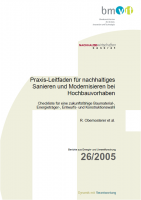nasa – Guideline on Sustainable Building Reconstruction
Project goal
The objective is to promote the acceptance, the technical and organizational support and the creation of implementation-oriented basis for sustainable rehabilitation and modernization projects in buildings; in a plain, clear and user-oriented form.
Summary
In the recent years, environmental protection measures have strongly concentrated on reducing emissions into the environment by employing filter facilities. For an enhanced environmental protection though, such an „end of pipe“ approach is much too short-ranged. Nowadays, approaches related to the precautionary principle are handled, which consider and optimise the entire life cycle of a product. Within the building industry, this means that each participating actor should arrange his field of action towards ecological viewpoints, so that environmental impacts should not occur at all or, respectively, that their effect is kept as small as possible. Here, all processes within the building activity are considered, from the planning and design over construction materials production and the construction itself up to the final disposal of the waste construction. In addition to ecological viewpoints, the linking of the latter with economical and social challenges has begun in the last years, and has thus resulted in the guiding principle of sustainable development.
The main problem relating to the implementation of sustainable aspects in the building practice is the considerable insecurity within this new subject. With this science being new and with a variety of aspects being cross-linked, an overall state of the art for sustainable construction is hardly available. In addition, sustainable development is considered also a process, which means that not single solutions alone are being looked for. Orientation support is needed, so that the entire spectrum of solutions can be elaborated that would make scientific knowledge approach the practice. The current project aims therefore at promoting acceptance, at expert and organisational support and at creating an implementation oriented basis for sustainable sanitation and modernisation schemes in structural engineering.
For this purpose, a user-friendly and practice-oriented guideline has been developed based on the assumption that each actor is an experienced specialist in his field and thus needs information reduced only to expert relevance. The guideline concept has been developed in cooperation with the concerned actors and in form of workshops, interviews and literature research. By considering single criteria presented as checkpoints, the guideline follows an exemplifying building activity. In total, more than 1500 checkpoints within 160 sanitation themes are summarised. The added information section acts as support for the implementation of each checkpoint, which contains e.g. recommendations, further reading sources, specific information etc. The guideline contains also an assessment relating to the involved actors.
The checklist is to serve the user (actor) as decision-making support (support to self-help). Each checkpoint in the guideline should be thus considered an option, a clue for implementing the sustainability criteria. This way, the actor is given the free choice as to which recommendations should be taken into account in the specific case. The response to the checkpoints is thus neither evaluated nor demanded. The guideline offers therefore the orientation of the different solution possibilities corresponding to the manifold interrelations within the building industry among functionality, carrying capacity, aesthetics, cost effectiveness, ecology, etc. The user disposes over the opportunity to develop himself creative and innovative solutions or to search efficiently for a solution by means of the clues offered. Thus it is the role alone of the actors involved in the concrete sanitation process to enable the implementation of the suggested requirements, supported by their experience and according to the latest state of the art and all building standards, by-laws and norms.
The actors themselves are the experts who, disposing over the specialised knowledge, can find the best solutions within the concrete theme. The project team is reliant on any suggestion or comment aiming at the further development of the guideline, and will highly appreciate such support.




